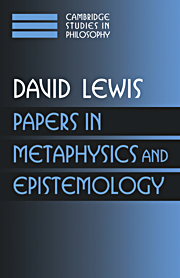Book contents
- Frontmatter
- Contents
- Introduction
- 1 New work for a theory of universals
- 2 Putnam's paradox
- 3 Against structural universals
- 4 A Comment on Armstrong and Forrest
- 5 Extrinsic properties
- 6 Defining ‘intrinsic’ (with Rae Langton)
- 7 Finkish dispositions
- 8 Noneism or allism?
- 9 Many, but almost one
- 10 Casati and Varzi on holes (with Stephanie Lewis)
- 11 Rearrangement of particles: Reply to Lowe
- 12 Armstrong on combinatorial possibility
- 13 A world of truthmakers?
- 14 Maudlin and modal mystery
- 15 Humean Supervenience debugged
- 16 Psychophysical and theoretical identifications
- 17 What experience teaches
- 18 Reduction of mind
- 19 Should a materialist believe in qualia?
- 20 Naming the colours
- 21 Percepts and color mosaics in visual experience
- 22 Individuation by acquaintance and by stipulation
- 23 Why conditionalize?
- 24 What puzzling Pierre does not believe
- 25 Elusive knowledge
- Index
18 - Reduction of mind
Published online by Cambridge University Press: 08 February 2010
- Frontmatter
- Contents
- Introduction
- 1 New work for a theory of universals
- 2 Putnam's paradox
- 3 Against structural universals
- 4 A Comment on Armstrong and Forrest
- 5 Extrinsic properties
- 6 Defining ‘intrinsic’ (with Rae Langton)
- 7 Finkish dispositions
- 8 Noneism or allism?
- 9 Many, but almost one
- 10 Casati and Varzi on holes (with Stephanie Lewis)
- 11 Rearrangement of particles: Reply to Lowe
- 12 Armstrong on combinatorial possibility
- 13 A world of truthmakers?
- 14 Maudlin and modal mystery
- 15 Humean Supervenience debugged
- 16 Psychophysical and theoretical identifications
- 17 What experience teaches
- 18 Reduction of mind
- 19 Should a materialist believe in qualia?
- 20 Naming the colours
- 21 Percepts and color mosaics in visual experience
- 22 Individuation by acquaintance and by stipulation
- 23 Why conditionalize?
- 24 What puzzling Pierre does not believe
- 25 Elusive knowledge
- Index
Summary
I am a realist and a reductive materialist about mind. I hold that mental states are contingently identical to physical – in particular, neural – states. My position is very like the ‘Australian materialism’ of Place, Smart, and especially Armstrong. Like Smart and Armstrong, I am an ex-Rylean, and I retain some part of the Rylean legacy. In view of how the term is contested, I do not know whether I am a ‘functionalist’.
SUPERVENIENCE AND ANALYSIS
My reductionism about mind begins as part of an a priori reductionism about everything. This world, or any possible world, consists of things which instantiate fundamental properties and which, in pairs or triples or …, instantiate fundamental relations. Few properties are fundamental: the property of being a club or a tub or a pub, for instance, is an unnatural gerrymander, a condition satisfied by miscellaneous things in miscellaneous ways. A fundamental, or ‘perfectly natural’, property is the extreme opposite. Its instances share exactly some aspect of their intrinsic nature. Likewise for relations. I hold, as an a priori principle, that every contingent truth must be made true, somehow, by the pattern of coinstantiation of fundamental properties and relations. The whole truth about the world, including the mental part of the world, supervenes on this pattern. If two possible worlds were exactly isomorphic in their patterns of coinstantiation of fundamental properties and relations, they would thereby be exactly alike simpliciter.
It is a task of physics to provide an inventory of all the fundamental properties and relations that occur in the world.
- Type
- Chapter
- Information
- Papers in Metaphysics and Epistemology , pp. 291 - 324Publisher: Cambridge University PressPrint publication year: 1999
- 28
- Cited by

